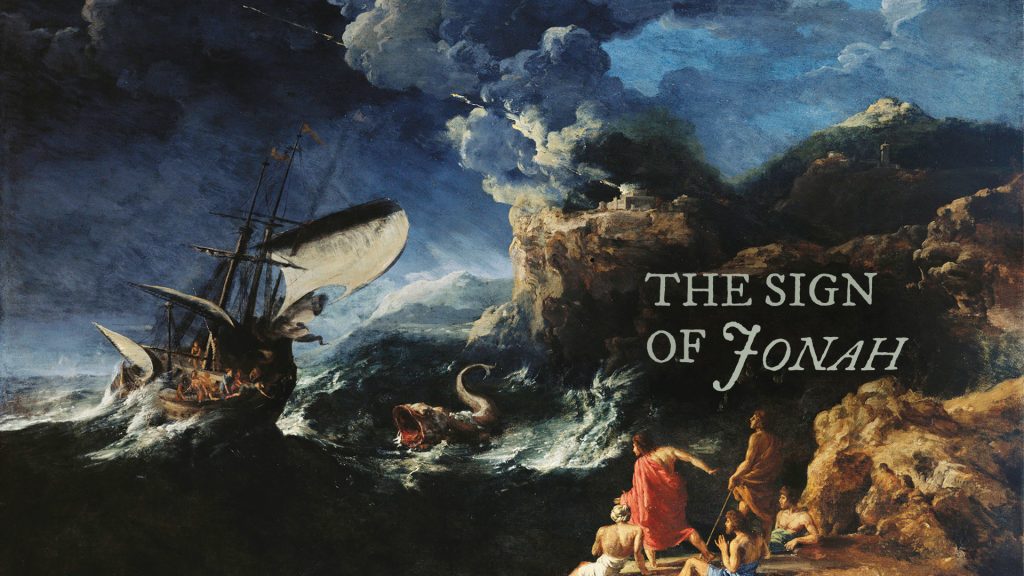The Sign of Jonah

by Joel D. Heck
“But [Jesus] answered them: An evil and adulterous generation seeks for a sign, but no sign will be given to it except the sign of the prophet Jonah” — Matthew 12:39
During my days as a university instructor in theology, I often used the book of Esther to show that the building of a new major league baseball park had been predicted in Esther. Xerxes, King of Persia, represented the Commissioner of Baseball. Vashti, Xerxes’ Queen, symbolized the old stadium that was about to be torn down. Esther represented the new stadium soon to be built. The archvillain Haman represented those forces against the new stadium, and Mordecai stood for the governor or mayor or congressman who championed the new stadium. These forces worked together, resulting in the prediction of the construction of a new baseball park. The correlation worked nicely but the problem was this: it wasn’t true.
I was showing my students how a similarity between biblical happenings and modern-day happenings does not prove that the former predicted the latter. Scholars call such similarities or patterns between Old Testament and New Testament people and events “typology.” It is a real tool for biblical interpretation but one that must be used with care. Some students of the Bible use Old Testament events to “prove” all sorts of New Testament theology, especially related to the End Times, but they end up misusing the Scriptures in the process.
The “sign of Jonah” is most often understood as typology, but remember that typology must be used carefully. Typology refers to the study of types, or patterns of similarities, between people, places, and events in the Old Testament and their corresponding people, places, and events in the New Testament. In every instance, the Old Testament pattern is a shadow of the New Testament pattern. Most often, typology shows the greatness of Jesus in comparison to someone like Joseph, whose humiliation in a pit and then in a prison, followed by his exaltation to the right hand of Pharaoh, bears some similarity to the humiliation and exaltation of Jesus. But the fact that you can show a similarity between two sets of people or events provides no assurance that that is what the Holy Spirit intended.
Some think that Jonah actually died in the belly of that “great fish” (Jonah 1:17), given the conditions inside the fish that would make life difficult. But nowhere does the text of Jonah or any other passage make that clear. An actual death and resurrection would blunt the typological interpretation, even if, in the long run, it matters little.
Typology is different from prophecy and fulfillment. The many spectacular prophecies from the Old Testament prophets about the coming Messiah invite our trust and admiration, especially at Christmastime, when we hear Isaiah’s prediction of the Virgin Birth (Isaiah 7:14) or Micah’s naming of the birthplace of the Messiah (Micah 5:2) or Jeremiah’s prediction of the New Covenant (Jeremiah 31:31-34). Other passages, such as Isaiah 53 and Psalm 22, are among those Old Testament passages that prophesy the death of the Messiah. In those clear instances of prophecy and fulfillment, we often have the words of a New Testament writer quoting an Old Testament passage, such as in the place where the birthplace of the Messiah is noted as being fulfilled in the birth of Jesus in Bethlehem. According to Matthew 2:6, for example, the birth of Jesus in Bethlehem fulfills Micah 5:2 (“In Bethlehem in Judea,” they replied, “for this is what the prophet has written: ‘But you, Bethlehem…’”). In the case of typology, we often don’t have a clear indication from the inspired writer. In the case of the sign of Jonah, though, we have Jesus’ words.
The passages from Matthew and Luke which contain Jesus’ words about the sign of Jonah are not Messianic prophecy in the sense described above but instead typology. R. T. France calls the sign of Jonah “a counterchallenge” to the challenge of Jesus’ opponents, who requested the sign, and “an explicit typological parallel.” Typology gives us a comparison with the higher level of that comparison in Jesus. Jonah experienced a virtual death or near death (the lesser level), whereas Jesus went through actual death (the higher level). The sign is Jesus’ resurrection, and the comparison is to death and resurrection. The “one greater than Jonah” (v. 11) outdid Jonah.
Treating the book of Jonah as something other than history too often causes the reader to miss its message as well as its important connection to the New Testament.
Few Messianic prophecies focus on the resurrection (the later verses in Isaiah 53 and Psalm 22 are exceptions). The sign of Jonah, however, turns our attention to the resurrection with its rather explicit prediction of Jesus’ resurrection.
Many interpretations have been suggested for the book of Jonah: (1) myth, (2) allegory (which has fallen out of favour), (3) parable (a more relaxed version of allegory, the prevailing view today, especially among critical scholars, but the book is too long, and there is no interpretation to the parable), (4) legend (a story coming from the past, popularly regarded as historical, although not verifiable), (5) a modern cartoon, (6) a sermon on a theme, (7) a prophetic novel, and (8) history.
Treating the book of Jonah as something other than history too often causes the reader to miss its message as well as its important connection to the New Testament. Some of these views are attempts to explain away the supernatural elements, which includes resurrection, and to explain the improbability of an Israelite prophet going to Nineveh and succeeding in his work.
Jesus mentions the sign of Jonah in Matthew 12:39-41 (“The men of Nineveh will arise at the judgment…”) and in Luke 11:29-32. We focus on Matthew’s account, where Jesus makes the sign of Jonah more explicit. The sign of Jonah, He says, is the three days and nights that Jonah was in the belly of the great fish—an anticipation of Jesus being buried for the same period of time, but also implying His rising again. Matthew writes (12:39-41):
He [Jesus] answered, “A wicked and adulterous generation asks for a sign! But none will be given it except the sign of the prophet Jonah. For as Jonah was three days and three nights in the belly of a huge fish, so the Son of Man will be three days and three nights in the heart of the earth. The men of Nineveh will stand up at the judgment with this generation and condemn it; for they repented at the preaching of Jonah, and now one greater than Jonah is here.
Jonah’s “death and resurrection” (assuming that he did not actually die) anticipate (but do not predict) Jesus’ own death and resurrection, and also argue for the historicity of the book and its authorship by Jonah. No one else but Jonah would have known the details of many of the events in the book of Jonah. Jonah was as good as dead, while Jesus was actually dead. Jonah was given a new lease on life, a sort of “resurrection,” whereas Jesus actually came back to life. Jesus once stated: “No one takes it [My life] from Me, but I lay it down of My own accord” (John 10:18). [By the way, first-century Jewish custom counted any part of a day as a whole day (Genesis 42:17-18; 1 Samuel 30:12-13; Esther 4:16, 5:1).]
Jesus’ purpose for mentioning the sign of Jonah is apparently the lack of faith from the Pharisees and teachers of the law. They asked for a sign when they had already seen Jesus’ miracles. They were requesting “some sort of undeniable, overwhelming proof that Jesus is who he claims to be.” And they wanted the sign soon. Jesus refused because of their unbelief. When we become impatient that a prayer is seemingly not answered, we can face the same criticism that Jesus leveled against the Pharisees and teachers of the law. The Ninevites repented; the Pharisees did not. Let us, rather, trust that “in all things God works for the good of those who love Him” (Romans 8:28), believe that He answers every prayer, and see the resurrection of our Lord Jesus Christ as a demonstration of the love that He has for us and all believers.
—————
Rev. Dr. Joel D. Heck is Interim President of Concordia Lutheran Seminary in Edmonton.




